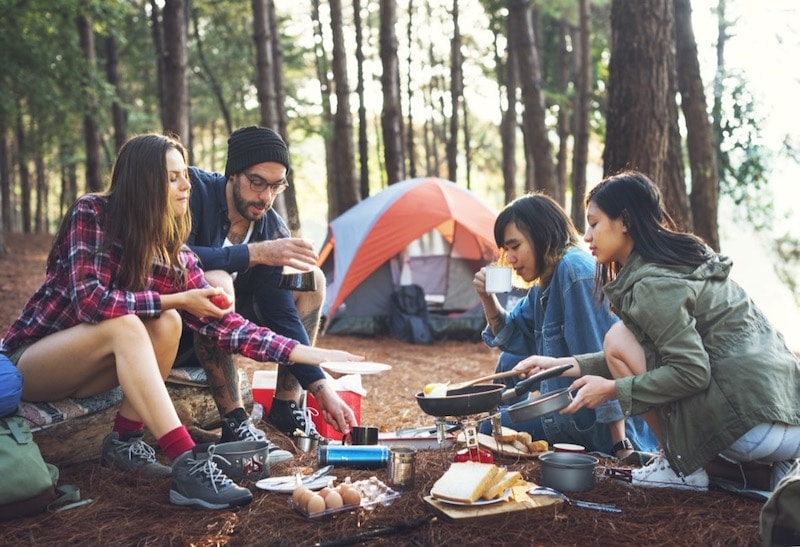There’s no better way to enjoy the outdoors with friends and family or even solo than to pack up a few necessities and head out to your favorite camping spot. However, it’s important to be sure the food and water you intend to use is safe, whether it’s brought from home or foraged in the wilderness. Neglecting food safety is the surest way to make a camping trip go bad. Food or water contamination can spoil any trip, and can even lead to dangerous and long-lasting medical conditions that you will almost certainly regret.
What We'll Cover
- The Importance of Practicing Proper Food Safety
- Keep Cold Food Cold
- The Best Way to Be Sure
- Use a Camping Cooler
- Use Frozen Water Bottles as Ice Packs
- Only Eat Meat Kept Below 40°F
- Cook Meats Properly
- Preventing Cross-Contamination While Cooking
- Wash Your Hands
- Wash Your Utensils and Containers
- Have Different Utensils and Containers For Different Foods
- Avoid Having Leftovers
- Safe Drinking Water
- Don’t Drink Water Directly from a Natural Source
- Bring Your Own Clean Water to Drink
- Use Water Filtering and Purifying Equipment
- Symptoms of Food Poisoning
- Conclusion
When camping, it’s probably best to keep any food preparation you will be performing as simple as possible. Avoid the use of perishable food items, and always use the appropriate hygiene measures to ensure the safety of yourself and the members of your party. However, we understand barbecuing and cookouts are a staple of the camping community. For this reason, it’s necessary to attend to all the requisite food preparation safety protocols when cooking in the great outdoors.
Here, we will discuss the basics of food and water safety to help make sure your outdoor excursion is safe and enjoyable for everyone.
The Importance of Practicing Proper Food Safety
There are many dangerous and disease-causing microbes, which can and will contaminate your food and water if proper safety precautions are not followed. Epidemiologists have identified more than 250 foodborne diseases. Many of these diseases are infectious and caused by a range of viruses, bacteria, and parasites. Dangerous chemicals and toxins are also a significant cause for concern and can cause serious illness. Foodborne illness is the greatest danger to anyone braving the outdoors. For that reason, food safety and food hygiene should be your number one safety priority.
The following are some basic food prep and safety tips. Depending on your location, time of year, and other factors, greater precaution may be required. Always consult local authorities for any infection hazards, which may be present in local water supplies, as well as any pathogens local wildlife are likely to carry. Special care is to be taken when eating wild game not prepared by a professional. Hunters and those in a hunter’s party are advised not to eat wild game without prior inspection by a qualified food service professional.
Keep Cold Food Cold
The importance of refrigeration cannot be overestimated. Refrigeration has saved many lives over the decades and is your first defense against microbes, insects, and other organisms spoiling food and causing illness. Your ability to chill meats and other foods is among your first lines of defense against foodborne illness.
The Best Way to Be Sure
The best way to make sure your food is safe is by keeping it cool. When it comes to refrigerating food for camping, you have a lot of options. Some options are better than others, but there are a few basic and easy-to-apply low temperatures to preserve your food while camping.
Use a Camping Cooler
A high quality, insulated camping cooler or camping refrigerator is your first line of defense from foodborne illnesses. A cooler will retain cold air and prevent critters, germs, and other forms of contamination from getting into your food.
Use Frozen Water Bottles as Ice Packs
It can be tempting to use ice packs or loose ice cubes to chill your camping cooler. But there is a simpler and more useful alternative: frozen water bottles. Using frozen water bottles allows you to store your food and beverages without having to make extra space for ice. Best of all, as your food supply diminishes, and your storage needs decrease, you can simply drink the water in your bottles. It’s a good way to maximize your pack space, keep your trash-pack burden at a minimum, and reduce the total amount of variables leading to food contamination.
Only Eat Meat Kept Below 40°F
Once meats and other similar foods have thawed, they may be contaminated, and refreezing them is not recommended. Also, foods not stored at 40°F or below cannot reliably be cooked enough to be made safe. Even if you are confident you can effectively sterilize contaminated food at home, when cooking from a campfire or setting up your camping kitchen, it’s almost impossible to be sure it is safe. Lunch meats are meant to be eaten cold and might be your best bet if you’re inexperienced at cooking outdoors.
Cook Meats Properly
Cooked meat should always be treated with special care. Contracting a foodborne illness while camping can be especially dangerous, since medical care will often be harder to reach than it would be at home. Cook ground beef, pork, lamb, veal and similar meats to 160°F. Hot dogs should be cooked to 165°F. Cook poultry to 165°F. Unground beef, pork, lamb and veal should be cooked to 145°F. Let these meats rest for three minutes before carving or consuming. If you’re using a recipe from a camping cookbook, the recipe may also include the internal temperature the meat should be at.
You should have a meat thermometer just like the one you have at home to test the temperature of any meats mentioned in this section. Insert the thermometer into the center of the meat and give it time to indicate the appropriate temperature. Do not remove the thermometer and reuse it unless and until it is sterilized. Having more than one meat thermometer might be a good idea.
Preventing Cross-Contamination While Cooking
Even if you believe you are observing all of the necessary precautions, it only takes one mistake for a dangerous pathogen or parasite to be transferred from any surface onto your food. Always be aware of the last thing you have touched or the last thing the item in your hand has touched before moving on to another task. Here are a few guidelines to help ensure cross-contamination does not occur.
Wash Your Hands
Use eco-friendly soap and wash your hands before and after handling meat, utensils, dishware, or anything that will touch food. Wash your hands between each food-handling task, before eating and serving food, and after eating and cleaning up.
Wash Your Utensils and Containers
Just like the meat thermometer we mentioned above, it can be easy to forget about the cross-contamination hazards of careless utensil use. Try to limit each utensil to a single container and/or food item. Just as you wash your hands at every juncture, also wash utensils that move from one tray to another, one food item to another, and so on.
Have Different Utensils and Containers For Different Foods
Limiting each utensil to a specific type of food is a good idea while cooking. For example, you would not use the same tool to flip the meat that you use to stir a soup or stew. Likewise, don’t place food on a tray or container that has had a different type of food, or a food item that has been in an earlier stage of preparation. Try to keep multiple cuting boards and utensils in your portable camping kitchen’s campting kitchen organizers.
Once an uncooked food item has been removed from a container, no food should go back into that container.
Avoid Having Leftovers
Leftovers from any camping trip should always be avoided. Even if you follow all the proper precautions, there is always a risk of foods going bad before you make it back home. By the end of your trip, chances are that your ice will be used up or melted, and any pathogens, bugs, or parasites will have had the maximum opportunity to breed, grow, and do all of the unpleasant things they do. Your best bet is to avoid leftovers and to responsibly discard any you may have. Food stored at temperatures between 40°F and 140°F is at the highest risk of developing bacteria. Of course, wasting food is not optimal. If you do have any leftovers you don’t want to throw away, be sure to heat them thoroughly to kill any bacteria or unwanted disease-causing organisms.
Do not throw away unused food at the campsite. This can attract dangerous animals and pose a hazard to other campers.
Safe Drinking Water
The ability to obtain safe water for drinking has always been a challenge for people in the outdoors. Native Americans have given frightening names to locations where contaminated water exists. Today, we have more options available to us for cleaning and storing water. Still, avoiding water-borne disease and obtaining safe water is not something to be taken lightly.
Don’t Drink Water Directly from a Natural Source
Unless you are in a desperate survival situation, there is no reason to drink directly from any river, stream, lake, or pond. Camping water purifiers do exist, which can be useful in an emergency situation. However, it is always better to bring the water you drink. Save water purifiers for emergencies if possible.
Bring Your Own Clean Water to Drink
Bringing clean water with you is the only way to be completely sure your drinking water is clean and safe. Even high-quality portable water purifiers can be defeated by toxic chemicals, and by the most pernicious biological hazards. Only bottled water brought from home comes with any reasonable guarantee of safety and purity.
Use Water Filtering and Purifying Equipment
As mentioned, water purifying equipment is a good option. There are a number of camping water filters and purifiers on the market. If you intend to use one of these options, be sure it is of a high quality.
As stated, using bottled water from home is the ideal. However, in an emergency situation, filters and purifiers are good options. Our advice is to only use these as a backup to your bottled water supply.
Symptoms of Food Poisoning
If you suspect you or anyone in your party has contracted a foodborne illness, you should evacuate your campsite immediately and obtain medical attention. Do not wait to see if the affected person will “get over it.” Many foodborne illnesses may seem mild at first. But in a matter of hours, sometimes faster, these illnesses can become serious and even life-threatening.
The common signs of potentially dangerous food poisoning include, but are not limited to:
- Nausea
- Stomach cramps
- Vomiting
- Diarrhea
Less common signs of food poisoning may be:
- Headache
- Skin discoloration
- Disorientation
- Sudden onset of lethargy
- Irregular heart rhythms
- Dilatation of the eye not commensurate with lighting conditions
Conclusion
While many people consider wild animals and weather to be the primary dangers to be considered during a camping trip, the truth is contaminated food is much more dangerous than any other factor. Food poisoning and foodborne illness should always be taken very seriously and should be attended to as early as possible by a qualified medical professional.
Protect yourself, and the rest of your camping party by following the proper food storage and preparation safety steps discussed above.
The responses below are not provided, commissioned, reviewed, approved, or otherwise endorsed by any financial entity or advertiser. It is not the advertiser’s responsibility to ensure all posts and/or questions are answered.





